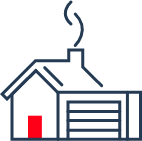When shopping for a home, most people focus on things like square footage, the layout, or the size of the backyard. However, one factor that often gets overlooked is how the home's location can influence something very important to your budget – your insurance premiums.
Where you live can significantly affect how much you pay for homeowners insurance, sometimes more than the features of the home itself. Why does location matter so much? Insurers base premiums on calculated risks.
They evaluate the likelihood of damage or losses happening to a property, and a home's surroundings play a big role in that risk assessment. If you've ever wondered why two similar homes in different areas end up with vastly different insurance costs, you're about to find out why.
1. CRIME RATES & NEIGHBORHOOD SAFETY
Crime rates are one of the first things insurance companies look at when assessing premiums for a home. If your home is in an area with a high incidence of burglaries, vandalism, or other crimes, your premiums may be higher. Why? Crime in the area increases the likelihood of claims being filed for stolen items or property damage.
For instance, a home in a neighborhood known for safety, with plenty of lighting and low crime statistics, will usually cost less to insure than a home in an area with frequent break-ins.
To lower your insurance costs, consider investing in a home security upgrade, especially in an area with moderately high crime levels. Some insurers offer discounts if your home includes additional security features like alarm systems, motion sensor lights, or surveillance cameras, as these reduce potential risks. Not only do these measures provide peace of mind, but they can also lead to meaningful savings over time.
2. NATURAL DISASTER RISKS
Living in a scenic coastal home with breathtaking ocean views might sound like a dream, but it can also come with higher insurance costs. Why? Because areas prone to natural disasters, like hurricanes, tornadoes, wildfires, or floods, carry a higher risk of damage. Homes in these regions are more likely to require costly repairs or rebuilds after a disaster strikes, and insurance companies factor those potential payouts into your premium.
For example, if you live in Florida, where hurricanes are common, your insurance policy may include additional coverages such as windstorm or flood insurance, which can increase your overall premium. Similarly, homes in wildfire-prone areas of California often require separate fire insurance policies.
If you're shopping for a home or already live in an at-risk area, you can take proactive steps to lower your risk profile. Installing storm shutters, reinforcing your roof, or clearing vegetation around your property can protect your home and may lead to discounts from your insurer.
3. PROXIMITY TO EMERGENCY SERVICES
Another key factor is how close your home is to emergency services, such as fire stations, police departments, and hospitals. Proximity to these resources can lower the time it takes to respond to disasters or emergencies, which reduces the potential extent of damage.
For instance, homes within a short distance of a well-equipped fire station may see lower insurance premiums compared to homes farther away. Similarly, easy access to fire hydrants in your neighborhood can also make a difference.
This doesn't mean you need to live next door to a firehouse, but generally, homes located within a few miles of one tend to enjoy lower premiums. If you're moving to a more rural area with limited emergency services, be prepared for potentially higher costs.
4. NEIGHBORHOOD CHARACTERISTICS & SURROUNDINGS
The characteristics of your neighborhood play a surprising role in determining insurance premiums. Insurers consider factors such as the age and condition of nearby homes, the type of infrastructure in the area, and even how well your neighbors maintain their properties.
If you live in an older neighborhood with aging water systems or poor road conditions, insurers may view this as an elevated risk for issues like burst pipes or accidents. Likewise, insurers are more likely to offer fairer premiums if your neighborhood is newer, with modern utilities and well-kept properties.
Other local features can also sway premiums. A home near busy highways or airports might cost more to insure due to the increased likelihood of accidents or noise-related damage. Similarly, wooded areas can pose risks for pest infestations or falling tree branches, which might also affect your cost of coverage.
5. CLIMATE & WEATHER PATTERNS
Beyond specific natural disasters, your area's general climate and weather conditions are also assessed. While you might not live in an overtly high-risk area, regions with frequent hailstorms, heavy snowfall, or extreme temperatures can still raise your home's insurance premiums.
For instance, regions that face harsh winters often deal with frozen pipes or roof damage due to heavy snow, resulting in more insurance claims. On the other hand, locations with long, dry seasons might be at higher risk for structural wear and tear.
Being aware of your local climate can help you take preventive measures, such as properly insulating pipes in cold climates or sealing cracks and openings to protect against dry heat.
4 Tips for Managing Insurance Costs
Although you can't control most aspects of your home's location, there are ways to manage the costs associated with high-risk areas. Here are some practical tips to consider:
- Bundle Insurance Policies: Many insurers give discounts if you bundle home and auto insurance under one provider.
- Upgrade Your Home's Safety Features: Adding storm shutters, fire-resistant materials, or security systems can dramatically reduce premiums.
- Shop Around: Different insurance companies may assess location risks differently, so getting quotes from multiple providers is key to finding the best rate. Ask
- About Discounts: Some insurers might offer incentives for new homebuyers or homeowners who haven't filed claims within a certain time frame.
The location of your home plays a massive role in determining your insurance premiums. From crime rates and proximity to emergency services to local weather patterns and disaster risks, insurers analyze various factors before coming up with your rates.
While some location-related risks are unavoidable, you can always take steps to minimize the impact on your premiums. By staying informed and proactive, you can make smarter decisions about where to live and how to protect your home.
Whether you're a first-time homeowner or reevaluating your current policy, understanding these factors will help you better plan for the true cost of homeownership – and the peace of mind that comes with protecting what matters most.
If you need help finding the best homeowners insurance coverage for the best price, start by speaking to a SimplyIOA agent at 833.872.4467 or get a homeowners insurance quote online now.











